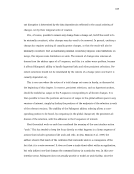83
Definition�4.1:Each�address�is�a�tuple(p, i)wherepis�a�change�path,iis�a�nonnegative
integer�and:
1. A�change�path,pis�a�(possibly�empty)�sequence�of�change�IDsI
1 …I
n ,.
2. The�last�change�ID,I
n (if�p�is�nonempty)�denotes�an�insertion,
3. The�indexiis�in�the�interval0…Nwhere�N�is�the�length�of�the�sequence�inserted�by
change�I
n .This�denotes�a�position�in�the�sequence�of�items�inserted�by�the�insertion
with�ID�I
n .
4. No�ID�may�occur�more�than�once�in�the�change�pathp.
5. There�is�only�one�legal�address�with�a�null�change�path,�and�it�must�have�an�index�of
0.�This�special�address,((), 0),is�referred�to�asnil.
6. Each�ID�in�the�change�path,I
1 …I
n–1 ,must�designate�move�or�copy�operations.�(We
will�discuss�the�effect�of�these�on�the�ordering�of�addresses�in�Section�4.3.2).
The�intention�behind�this�addressing�system�is�as�follows:
• The�first�operation�made�in�any�document�must�be�an�insertion�whose�target�is�the�spe-
cial�address�nil.
• An�insertion�defines�an�address�for�each�inter-item�gap�in�the�sequence�that�it�inserts,
including�the�positions�before�the�first�element�(0),�and�after�the�last�element�(N).
• Addresses�at�the�destination�of�one�or�more�copy�and�move�operations�are�identified�by
the�location�where�an�initial�insertion�occurred.�The�other�elements�in�the�path�repre-
sent�successive�move�or�copy�changes�that�affected�the�original�address.
• The�set�of�addresses�is�finite,�and�does�not�contain�any�addresses�that�would�represent
causal�“loops”,�for�instance�the�results�of�a�move�applied�to�its�own�destination.
Thus,�data�is�always�identified�by�reference�to�the�original�insertion�that�created�it,�re-
gardless�of�what�other�changes�may�affect�that�data.�The�same�contents�may�have�more�than
Definition�4.1:Each�address�is�a�tuple(p, i)wherepis�a�change�path,iis�a�nonnegative
integer�and:
1. A�change�path,pis�a�(possibly�empty)�sequence�of�change�IDsI
1 …I
n ,.
2. The�last�change�ID,I
n (if�p�is�nonempty)�denotes�an�insertion,
3. The�indexiis�in�the�interval0…Nwhere�N�is�the�length�of�the�sequence�inserted�by
change�I
n .This�denotes�a�position�in�the�sequence�of�items�inserted�by�the�insertion
with�ID�I
n .
4. No�ID�may�occur�more�than�once�in�the�change�pathp.
5. There�is�only�one�legal�address�with�a�null�change�path,�and�it�must�have�an�index�of
0.�This�special�address,((), 0),is�referred�to�asnil.
6. Each�ID�in�the�change�path,I
1 …I
n–1 ,must�designate�move�or�copy�operations.�(We
will�discuss�the�effect�of�these�on�the�ordering�of�addresses�in�Section�4.3.2).
The�intention�behind�this�addressing�system�is�as�follows:
• The�first�operation�made�in�any�document�must�be�an�insertion�whose�target�is�the�spe-
cial�address�nil.
• An�insertion�defines�an�address�for�each�inter-item�gap�in�the�sequence�that�it�inserts,
including�the�positions�before�the�first�element�(0),�and�after�the�last�element�(N).
• Addresses�at�the�destination�of�one�or�more�copy�and�move�operations�are�identified�by
the�location�where�an�initial�insertion�occurred.�The�other�elements�in�the�path�repre-
sent�successive�move�or�copy�changes�that�affected�the�original�address.
• The�set�of�addresses�is�finite,�and�does�not�contain�any�addresses�that�would�represent
causal�“loops”,�for�instance�the�results�of�a�move�applied�to�its�own�destination.
Thus,�data�is�always�identified�by�reference�to�the�original�insertion�that�created�it,�re-
gardless�of�what�other�changes�may�affect�that�data.�The�same�contents�may�have�more�than





























































































































































































